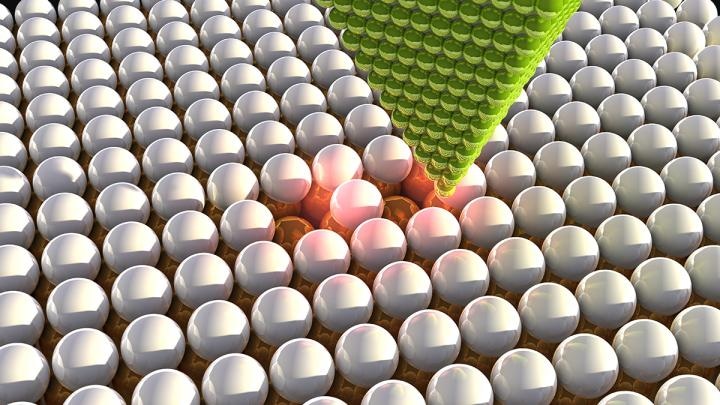Mar 28 2017
 The tip of a scanning tunneling microscope (STM) above chlorine atoms that have been deliberately moved. By moving individual atoms under their microscope, scientists were able to arrange vacancies in a single layer of chlorine atoms and create atomic lattices with a predetermined electrical response. (CREDIT - Ella Maru Studio & Aalto University)
The tip of a scanning tunneling microscope (STM) above chlorine atoms that have been deliberately moved. By moving individual atoms under their microscope, scientists were able to arrange vacancies in a single layer of chlorine atoms and create atomic lattices with a predetermined electrical response. (CREDIT - Ella Maru Studio & Aalto University)
A team of researchers at Aalto University have created artificial materials with engineered electronic properties.
By moving individual atoms under their microscope, the researchers were able to build atomic lattices with an engineered electrical response. The probability of precisely arranging the atoms on a sample push 'designer quantum materials' closer to reality. By positioning atoms in a lattice, the electronic properties of the material could be engineered via the atomic structure.
The research team, working at a temperature of 4 °K, made use of a scanning tunneling microscope (STM) to position vacancies in a single layer of chlorine atoms supported on a copper crystal.
The correspondence between atomic structure and electronic properties is of course what happens in real materials as well, but here we have complete control over the structure. In principle, we could target any electronic property and implement it experimentally.
Dr. Robert Drost, Aalto University
Using their atomic assembly technique, the team demonstrated total control by producing two real-life structures inspired by vital model systems with striking electronic properties.
The technique is not restricted to the chlorine system preferred by the research team either. The same technique can be used in numerous well-understood systems in surface and nanoscience and could even be applied to mesoscopic systems, such as quantum dots, which are controlled via lithographic procedures.
There are many fascinating theoretical proposals that don't exist in real materials. This is our chance to test these ideas experimentally.
Teemu Ojanen, Academy Research Fellow, Aalto University